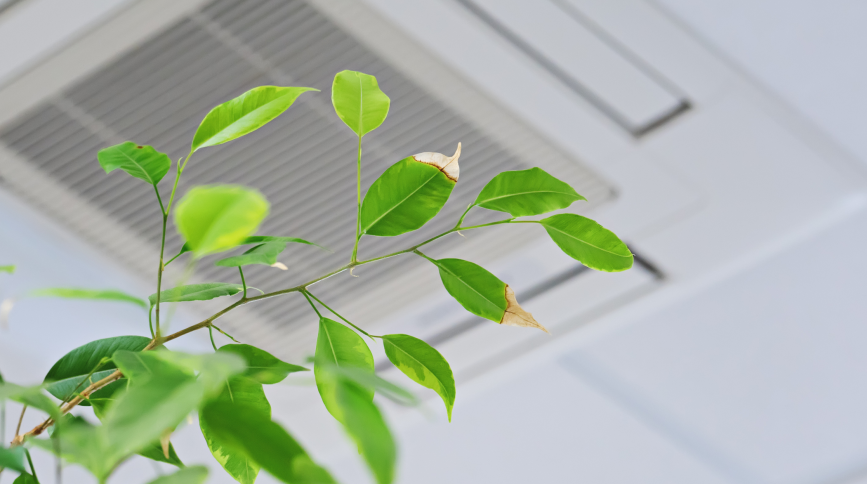When it comes to creating a healthy, comfortable indoor environment, air quality is often the first concern that comes to mind. At Air Quality Assessors (AQA), we frequently hear this question from clients: “Does humidity really affect indoor air quality?” The short answer: absolutely.
Humidity plays a powerful and often underestimated role in determining how clean and breathable indoor air is. Excess moisture can turn a home or office into a breeding ground for mold, mildew, dust mites, bacteria, and even viruses—all of which pose serious health risks. On the other end of the spectrum, air that is too dry can lead to discomfort, respiratory issues, and damage to property.
Striking the right balance is essential. Let’s explore how humidity levels impact indoor air quality, what the ideal humidity range is for your home, and why managing moisture should be a top priority for any indoor environment.

Humidity refers to the amount of water vapor in the air. Indoors, both excessive and insufficient humidity levels can negatively impact the air we breathe, the structural integrity of our homes, and our overall well-being.
Here’s how high humidity in particular contributes to poor indoor air quality:
When relative humidity (RH) rises above 50%, it creates an environment that supports the proliferation of airborne contaminants like mold spores, dust mites, and other allergens. These pollutants thrive in moist conditions and can become airborne, aggravating respiratory conditions such as asthma and allergies. Individuals with compromised immune systems, children, and the elderly are especially vulnerable.
Moisture is mold’s best friend. Humid conditions create the perfect environment for mold and mildew to flourish—especially in hidden or poorly ventilated areas like behind walls, beneath flooring, or in attics. Once mold begins to grow, it releases spores into the air, further reducing indoor air quality and potentially leading to serious health consequences including sinus infections, headaches, and even long-term respiratory diseases.
High humidity levels can make the air feel heavier, which impairs natural airflow and ventilation. This stagnant air traps pollutants inside your home, compounding indoor air quality issues. In areas with little to no fresh air exchange, pollutant concentrations can rise rapidly, leading to what’s commonly referred to as “sick building syndrome.”
Warm, moist environments are ideal breeding grounds for harmful bacteria and viruses. While not all pathogens thrive in humid conditions, several do—particularly those that cause respiratory and gastrointestinal infections. Unchecked humidity can contribute to the spread of illness, especially in densely populated indoor settings like schools and workplaces.
Humidity doesn’t just affect health—it impacts comfort, too. When the air is humid, sweat evaporates more slowly, making it harder for the body to cool down. This can lead to overheating, fatigue, and in extreme cases, heat exhaustion or heat stroke, particularly for people with underlying health conditions.
Experts generally agree that the healthiest indoor relative humidity falls between 40% and 60%. This range provides a comfortable environment while limiting the growth of allergens and reducing the likelihood of material damage inside your home.
But why this range? Let’s break it down:
Encourages the growth of mold, mildew, and dust mites.
Can trigger or worsen respiratory issues such as asthma and allergies.
Makes indoor spaces feel stuffy, hot, and uncomfortable.
Promotes condensation on windows, walls, and ceilings—leading to water damage and possible structural degradation.
Can warp or degrade wooden furniture, flooring, and building materials.
Increases the likelihood of unpleasant odors from damp fabrics or hidden mold.
Causes dry skin, chapped lips, and irritated eyes and nasal passages.
Worsens conditions like eczema and sinusitis.
Increases susceptibility to infections by drying out the mucous membranes that trap pathogens.
Causes wooden furniture and flooring to crack or shrink.
Leads to the buildup of static electricity, which can damage electronics and create discomfort.
Clearly, extremes in either direction can have significant consequences for both health and home. The 40–60% range represents a sweet spot that balances comfort, safety, and preservation.
Maintaining the ideal indoor humidity level isn’t always straightforward. One reason is that different pollutants and biological contaminants thrive at different moisture levels. For example, dust mites are most active at around 70–80% RH, while certain molds may begin to grow at 60% RH. Conversely, viruses like the flu may spread more easily in drier conditions, particularly below 30% RH.
This variation means that a single “ideal” humidity level may not effectively eliminate every possible pollutant. However, maintaining a controlled middle ground (typically 40–60%) helps to minimize most biological threats while ensuring a comfortable and healthy living environment.
The ideal indoor humidity level should achieve three main goals:
Ensure occupant comfort. The air should not feel overly dry or oppressively damp.
Limit biological contaminants. Mold, bacteria, viruses, and allergens should be kept in check.
Reduce chemical exposure. Many building materials release volatile organic compounds (VOCs) at higher rates under extreme humidity. Balanced humidity slows down this off-gassing process and keeps pollutant levels lower.
Achieving ideal humidity levels starts with awareness and monitoring. Here’s how homeowners and building managers can stay on top of indoor humidity control:
A hygrometer is an inexpensive tool that measures indoor humidity. Many smart thermostats now come with built-in humidity sensors, allowing for real-time monitoring. Placing a hygrometer in key areas such as the living room, bedroom, and basement can help you identify problem zones.
Depending on your climate and indoor conditions, you may need mechanical assistance:
Dehumidifiers remove excess moisture from the air and are especially useful in basements, bathrooms, and humid climates.
Humidifiers add moisture to dry air and are often needed during winter months when indoor heating systems cause relative humidity to plummet.
Some modern HVAC systems include built-in humidification or dehumidification features that automatically maintain optimal humidity levels.
Proper ventilation is essential to regulate moisture levels. Use exhaust fans in bathrooms and kitchens to remove excess steam and cooking moisture. Make sure dryer vents are directed outside and not into attics or crawl spaces. Opening windows when weather permits can also help reduce indoor humidity and bring in fresh air.
Moisture intrusion from leaks, condensation, or poor insulation can create chronic humidity problems. Regularly inspect your home for signs of water damage, such as stained ceilings, bubbling paint, or musty smells. Seal leaks around windows, doors, and roofs, and consider upgrading insulation to reduce humidity fluctuations.
While houseplants offer many benefits, they can contribute to excess indoor humidity, especially in poorly ventilated rooms. Aquariums and water features also increase moisture. Be mindful of their placement and ensure proper airflow.
Humidity levels fluctuate with the seasons. In winter, heating systems can dry out the air drastically, while summer often brings elevated humidity. Understanding these seasonal patterns helps you anticipate and address indoor air quality issues before they become problematic.
Winter: Use humidifiers to maintain 40–50% RH. Without moisture, you may experience dry sinuses, static shocks, and wood shrinkage.
Summer: Employ dehumidifiers or air conditioning to prevent RH from climbing above 60%. Watch for condensation on windows or musty odors, both signs of excess moisture.
Humidity control is not just a matter of comfort—it’s a foundational element of indoor air quality and health. Whether you’re trying to prevent mold, avoid respiratory illness, or simply preserve your furniture, managing indoor moisture levels is essential.
At Air Quality Assessors (AQA), we help clients across a wide range of settings—from private homes to office buildings and schools—understand and control their indoor environments. By maintaining an ideal humidity level between 40% and 60%, you can create a space that supports both physical health and structural longevity.
So the next time you think about indoor air quality, don’t forget the silent but powerful role that humidity plays. Because breathing clean air isn't just about what’s in it—it's also about how much moisture surrounds it.
Previous: CH2O Sensor – Detecting Formaldehyde to Safeguard Indoor Air Quality
Next: Industrial CO₂ Sensors for Safety and Monitoring




